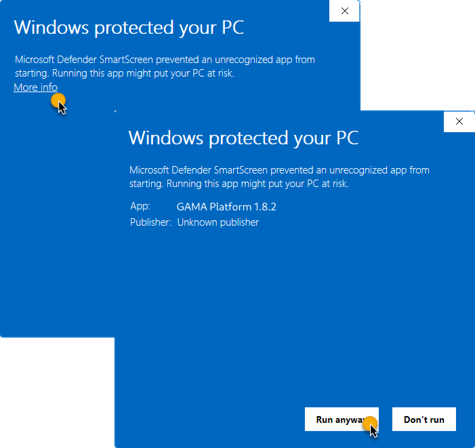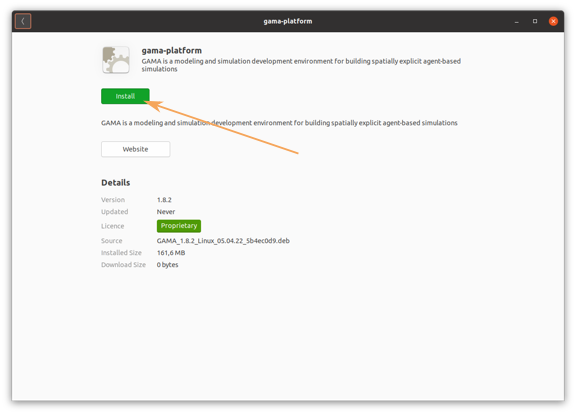-
Notifications
You must be signed in to change notification settings - Fork 99
Installation
We made efforts to make the last release of GAMA (1.9.2) as easy as possible to install, by providing a version with an embedded Java JDK, limiting the installation to a 3-steps procedure: download, install and launch.
GAMA 1.9.2 (the latest release) comes in a version for each 3 environments Windows, macOS and Linux packaged in easy to use installers. You simply have to go on the downloads page and pick the one for your system.
For advanced users :
- GAMA provide also some versions without embedded JDK allowing you to download a lighter archive
- This version requires Java 17 JDK to be installed on your computer (at least 17.0.3+7)
- It's also possible to download these 2 kinds of releases in simple zip archive (i.e. without installers), if you do so, please refer to the post-installation procedure at the end of this page
You'll find them on the Github Release page
After downloading the chosen GAMA version from the Downloads page for your computer, you only have run the installer, follow steps, and launch GAMA.
On windows, in addition to running GAMA from the zip file, we have to ways of installing it: the standard installer that you can get from our website, or the winget command.
This is the standard way of installing GAMA on windows.
-
Download the installer
.exefor Windows - Double-click on the downloaded
.exefile - Accept to run the app

- Follow the installer with the onscreen steps
- Done, you can start GAMA from your computer now.
NB: If you need to launch GAMA Headless, GAMA is installed under
C:\Program Files\Gamaby default
For advanced users, you may want to install GAMA from winget, the process is very simple:
- Open PowerShell
- Run the command
winget.exe install GamaPlatform.Gama
That's it, GAMA is installed on your computer!
In macOS we have two ways of installing gama: either the regular and user friendly .dmg installer, or the command line way with the homebrew package manager.
-
Download the installer
.dmgfor macOS- There is a built specifically for Macintosh M1 (also called with Apple silicon). You can check by clicking on the top-left apple,
About this Mac: the pop-up window will give details about the processor. If you're not sure and your Macintosh is from 2021 (or earlier) you probably need this specific version
- There is a built specifically for Macintosh M1 (also called with Apple silicon). You can check by clicking on the top-left apple,
- Double-click on the downloaded
.dmgfile - Drag'n'drop GAMA icon to your computer (Applications folder or Desktop for instance)

- Done, you can start GAMA from your computer now. At the first launch of GAMA, a popup window will appear warning you that GAMA is a software downloaded from internet and asking whether you want to open it. Click on the Open button.

NB: Note that the first launch of GAMA should be made in GUI mode (clicking on the icon) and not in headless mode. NB2: If you need to launch GAMA Headless after, GAMA is installed where you dragged and dropped the Gama.app
- Install brew on your computer: just follow the instruction from the website.
- Open a terminal
- Run the command
brew install gamaorbrew install gama-jdkfor the JDK version
You have two ways of installing GAMA on Debian and Ubuntu based systems: either by downloading a .deb installer or from the ppa repository.
- Open a terminal.
- Run the following commands.
sudo -i # Type your password
apt update
apt install ca-certificates # This might be needed if you are on debian, install it just in case
echo "deb [trusted=yes] https://ppa.gama-platform.org ./" | tee -a /etc/apt/sources.list-
You can now install GAMA with the command
apt install gama-platformorapt install gama-platform-jdkfor the JDK version. If you want to see all available packages head over to the ppa page. -
If you want to update GAMA, just run
apt update && apt upgradewhen a new release comes out.
- You can download a
.debfile from 3 different sources:- From the project downloads page under the Linux section.
- From the ppa page under the "All Packages" section.
- From the github release page
- Double-click on the downloaded
.debfile - Click on
install

- You could be asked for your password
- Done, you can start GAMA from your computer now
Note: If you need to launch GAMA Headless, GAMA is always installed under
/opt/gama-platform
AUR packages with latest version of GAMA exists for both version with and without embedded JDK. You can download them with a command as follows:
yay -S gama-platform{-jdk}
A Docker image of GAMA exists to execute GAMA Headless inside a container.
- Install docker on your system following the official documentation
- Pull the GAMA's docker you want to use (e.g.
docker pull gamaplatform/gama:1.9.2) - Run this GAMA's docker with your headless command (e.g.
docker run gamaplatform/gama:1.9.2 -help)
You can found all the tags and more detailed documentation on the Docker Hub or on the corresponding Github's Repository
GAMA 1.9.2 requires approximately 540MB of disk space and a minimum of 2GB of RAM (to increase the portion of memory usable by GAMA, please refer to these instructions).
If you decided to install gama yourself from the zip file, it is important that you change the Windows HDPI compatibility settings.
To do so, go to your Gama.exe file, right click and it and select properties, then go to the Compatibility tab and click on the Change high DPI settings button:

In the new window, check the Override high DPI scaling behavior option and select the System value.

These options are necessary to avoid most graphical problem using gama on Windows
- Installation and Launching
- Workspace, Projects and Models
- Editing Models
- Running Experiments
- Running Headless
- Preferences
- Troubleshooting
- Introduction
- Manipulate basic Species
- Global Species
- Defining Advanced Species
- Defining GUI Experiment
- Exploring Models
- Optimizing Model Section
- Multi-Paradigm Modeling
- Manipulate OSM Data
- Diffusion
- Using Database
- Using FIPA ACL
- Using BDI with BEN
- Using Driving Skill
- Manipulate dates
- Manipulate lights
- Using comodel
- Save and restore Simulations
- Using network
- Headless mode
- Using Headless
- Writing Unit Tests
- Ensure model's reproducibility
- Going further with extensions
- Built-in Species
- Built-in Skills
- Built-in Architecture
- Statements
- Data Type
- File Type
- Expressions
- Exhaustive list of GAMA Keywords
- Installing the GIT version
- Developing Extensions
- Introduction to GAMA Java API
- Using GAMA flags
- Creating a release of GAMA
- Documentation generation